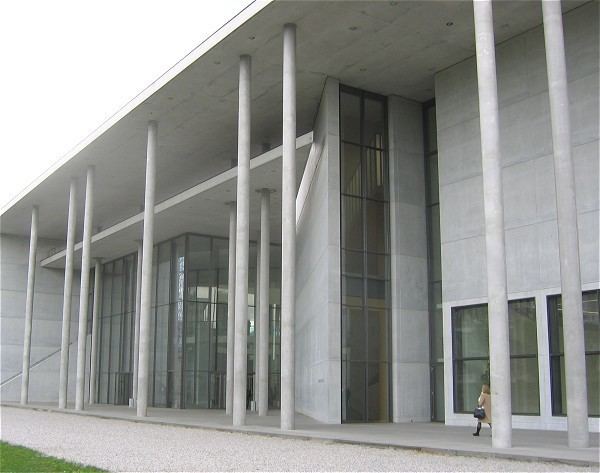Opened 2002 | ||
 | ||
Address Barer Str. 40, 80333 München, Germany Hours Closed today MondayClosedTuesday10AM–6PMWednesday10AM–6PMThursday10AM–8PMFriday10AM–6PMSaturday10AM–6PMSunday10AM–6PM Profiles | ||
Pinakothek der moderne
The Pinakothek der Moderne (= "(Art) Gallery of the Modern"; from Greek: "pinax" = "board", "tablet") is a modern art museum, situated in the city centre of Munich, Germany. Together with its two predecessors Alte Pinakothek and Neue Pinakothek (therefore locally also referred to as "Dritte" - i.e. "Third" - Pinakothek), as well as the Museum Brandhorst, the Antikensammlungen (= "Collections of Antiques"), the Glyptothek, the Städtische Galerie im Lenbachhaus and the new joint building of the Ägyptisches Museum and the Hochschule für Fernsehen und Film, currently both scheduled to open in 2012, it is part of Munich's "Kunstareal" (the "art district"). It is one of the world's largest museums for modern and contemporary art.
Contents
- Pinakothek der moderne
- Lecture jeff wall pinakothek der moderne 07 11 2013
- The building
- Collections
- Collection of Modern Art
- Collection of design
- Collection of works on paper
- Museum for architecture
- References
Lecture jeff wall pinakothek der moderne 07 11 2013
The building
Designed by German architect Stephan Braunfels, the Pinakothek der Moderne was inaugurated in September 2002 after seven years of construction. The $120 million, 22,000-square-meter building took a decade to finish because of bureaucratic objections to design and cost, which were ultimately bridged by private initiative and financing. The rectilinear facade, dominated by white and grey concrete, is interrupted by large windows and high rise columns, the latter supporting the extensive canopied roof. Each of the four corners of the building, connected by a central domed rotunda, is dedicated to a special collection. The Museum is thus divided into Art (Kunst), Architecture (Architektur), Design (Design) and Works on Paper (Graphik). Meaner tongues in Munich, whose inhabitants often express a certain loathing for what they regard as faceless modernism lacking any local and / or regional roots, denounce it as "the cardboard box".
The first floor, containing the art collection, has ample natural light from above, augmented by computer-controlled lamps, designed to keep a consistent, nearly shadowless illumination against the gray floors and white walls.
Collections
Before the opening of the Pinakothek der Moderne, art of the 20th century was largely relegated to the Haus der Kunst, or occasional contemporary exhibits in the Lenbachhaus. Today, the Pinakothek unifies the "Sammlung Moderne Kunst" (National Collection of Modern and Contemporary Arts, which is under supervision of the Bavarian State Painting Collections), the "Staatliche Graphische Sammlung" (National Collection of Works on Paper), the "Neue Sammlung" ('New Collection': National Museum for Design and Applied Arts) with the "Architekturmuseum der Technischen Universität" (Munich Technical University's Museum of Architecture), in one building and is deemed one of the most important and popular museums of modern art in Europe. The Danner Foundation opened in 2004 a new permanent exhibition area in the basement for the permanent loans from the Danner Jewelry Collection which presents contemporary works from over one hundred international goldsmiths.
Collection of Modern Art
In contrast to other cities Munich was not much affected by the Nazi regime's banning of modern art as "degenerate art," since only a few modern paintings were already collected by the "Tschudi Contribution" in 1905/1914, like the "Still Life with Geraniums" of Henri Matisse, the collection's first acquisition. Since 1945, however, the collection, previously exhibited in the Haus der Kunst, has grown quickly by purchase, as well as donations by individuals and several foundations. Various art movements of the 20th century are represented in the collection, including Expressionism, Fauvism, Cubism, New Objectivity, Bauhaus, Surrealism, Abstract Expressionism, Pop Art and Minimal Art.
In addition to a focused collection policy to individual priorities, the portfolio was extended in particular through the collections, "Theo Wormland" (surrealism), "Sophie and Emanuel Fohn" (who rescued degenerate art), "Woty and Theodor Werner" (images of Paul Klee and the Cubists), "Martha and Mark Kruss" (expressionism, especially the artists of Die Brücke), "Günther Franke" (works by Max Beckmann), "Klaus Gebhard" (North American artists such as Robert Rauschenberg and Jasper Johns) and the "collection of Franz, Duke of Bavaria" with contemporary German painters such as Jörg Immendorff and Sigmar Polke. Recent enrichment in the year 2006, the collection "Eleanor and Michael Stoffel" (German and North American art from the 1960s to the 1990s).
Collection of design
The Collection of applied modernist art was founded in 1925. With around 70.000 objects of industrial design, graphic design and the arts and crafts the "Neue Sammlung" is today one of the world's leading museums of 20th century applied art, and indeed the largest of industrial design. Parts of the expanded collection are exhibited in the basement of the Pinakothek der Moderne. Among others objects about motor vehicle design, computer culture, design of artistic jewelry and furnitures (e.g. the collection of chairs of Michael Thonet) are exhibited.
Collection of works on paper
The Bavarian State collection of work on paper has its origin in the Wittelsbach collections, especially in the print room collection of Charles Theodore, Elector of Bavaria. The ground floor shows alternating exhibitions of one of the most important collection of works on paper in Germany, with old German, Dutch and Italian drawings ( including masterpieces of Albrecht Dürer, Rembrandt, Michelangelo and Leonardo da Vinci ) and German and international drawings of the 19th - 21st century, e.g. from Paul Cézanne, Henri Matisse, Paul Klee and David Hockney.
Museum for architecture
The museum of the Technical University of Munich started with a donation of King Ludwig II of Bavaria for the newly founded university in 1868 and is today the largest one in Germany. The museum shows altering exhibitions in the ground floor. The collection shows especially drawings, blueprints, photographs, models and computer animations about the work of notable architects like François de Cuvilliés, Balthasar Neumann, Gottfried Semper, Le Corbusier, and Günther Behnisch.
